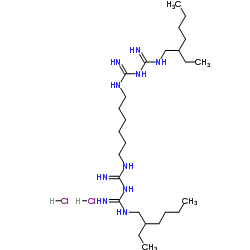Alexidine dihydrochloride

Alexidine dihydrochloride structure
|
Common Name | Alexidine dihydrochloride | ||
|---|---|---|---|---|
| CAS Number | 1715-30-6 | Molecular Weight | 581.712 | |
| Density | 1.1g/cm3 | Boiling Point | 658.2ºC at 760mmHg | |
| Molecular Formula | C26H58Cl2N10 | Melting Point | 220.6-223.4ºC | |
| MSDS | Chinese USA | Flash Point | 351.8ºC | |
| Symbol |

GHS07 |
Signal Word | Warning | |
Use of Alexidine dihydrochlorideAlexidine dihydrochloride is an anticancer agent that targets a mitochondrial tyrosine phosphatase, PTPMT1, in mammalian cells and causes mitochondrial apoptosis. Alexidine dihydrochloride has antifungal and antibiofilm activity against a diverse range of fungal pathogens[1]. |
| Name | Alexidine dihydrochloride,N,N''-Bis(2-ethylhexyl)-3,12-diimino-2,4,11,13-tetraazatetradecanediimidamidedihydrochloride |
|---|---|
| Synonym | More Synonyms |
| Description | Alexidine dihydrochloride is an anticancer agent that targets a mitochondrial tyrosine phosphatase, PTPMT1, in mammalian cells and causes mitochondrial apoptosis. Alexidine dihydrochloride has antifungal and antibiofilm activity against a diverse range of fungal pathogens[1]. |
|---|---|
| Related Catalog | |
| Target |
PTPMT1[1] |
| In Vitro | Alexidine dihydrochloride displays activity against most Candida spp.; MIC values of ≤1.5 μg/mL are observed for all isolates tested under planktonic conditions, with the exception of Candida parapsilosis and Candida krusei. Interestingly, Alexidine dihydrochloride also displays striking activity against clinically relevant fluconazole-resistant Candida isolates: C. albicans (CA2, CA6, and CA10), C. glabrata (CG2 and CG5), C. parapsilosis (CP5), and C. auris (CAU-09 and CAU-03)[1]. Inhibition of planktonic growth by Alexidine dihydrochloride reveals a complete inhibition of filamentation or proliferation of the imaged fungi. Alexidine dihydrochloride is able to decimate at low concentrations (1.5 to 6 μg/mL) mature biofilms of Candida, Cryptococcus, and Aspergillus spp. that are known to be resistant to almost all classes of antifungal drugs. In fact, at 10-fold-lower concentrations (150 ng/mL) of planktonic MICs, Alexidine dihydrochloride could inhibit lateral yeast formation and biofilm dispersal in C. albicans[1]. Alexidine dihydrochloride results in 50% killing of HUVECs and lung epithelial cells, at concentrations 5- to 10-fold higher than the MIC required to kill planktonically growing fungal pathogens[1]. |
| In Vivo | Chosen to focus on biofilm formation by C. albicans, since a murine biofilm model has been well established in this fungus and used for testing the effects of established and new antifungal agents. The effect of the drugs on the 24-h-old biofilms growing in the jugular vein catheters of mice is visualized microscopically, which reveals significantly lower density of the biofilms in catheters treated with Alexidine dihydrochloride. In fact, fungal CFU determination reveals that Alexidine dihydrochloride inhibits 67% of fungal biofilm growth and viability, compared to the control untreated biofilms[1]. |
| References |
| Density | 1.1g/cm3 |
|---|---|
| Boiling Point | 658.2ºC at 760mmHg |
| Melting Point | 220.6-223.4ºC |
| Molecular Formula | C26H58Cl2N10 |
| Molecular Weight | 581.712 |
| Flash Point | 351.8ºC |
| Exact Mass | 580.422302 |
| PSA | 167.58000 |
| LogP | 8.60460 |
| Vapour Pressure | 3.38E-17mmHg at 25°C |
| InChIKey | BRJJFBHTDVWTCJ-UHFFFAOYSA-N |
| SMILES | CCCCC(CC)CN=C(N)NC(N)=NCCCCCCN=C(N)NC(N)=NCC(CC)CCCC.Cl.Cl |
| Symbol |

GHS07 |
|---|---|
| Signal Word | Warning |
| Hazard Statements | H315-H319-H335 |
| Precautionary Statements | P261-P305 + P351 + P338 |
| RIDADR | NONH for all modes of transport |
|
Chemical interaction of alexidine and sodium hypochlorite.
J. Endod. 38(1) , 112-6, (2012) Recent studies have reported the color change and formation of precipitates containing para-chloroaniline (PCA) after a reaction of sodium hypochlorite (NaOCl) and chlorhexidine (CHX). Alexidine (ALX)... |
|
|
Quantitative high throughput screening using a primary human three-dimensional organotypic culture predicts in vivo efficacy.
Nat. Commun. 6 , 6220, (2015) The tumour microenvironment contributes to cancer metastasis and drug resistance. However, most high throughput screening (HTS) assays for drug discovery use cancer cells grown in monolayers. Here we ... |
|
|
Pan-antimicrobial failure of alexidine as a contact lens disinfectant when heated in Bausch & Lomb plastic containers: implications for the worldwide Fusarium keratitis epidemic of 2004 to 2006.
Eye Contact Lens 38(4) , 222-6, (2012) ReNu with MoistureLoc (ReNuML), containing the antimicrobial agent alexidine 0.00045%, was associated with the Fusarium keratitis epidemic of 2004 to 2006. Although a single-point source contamination... |
| N,N''''-1,6-Hexanediylbis[N'-(2-ethylhexyl)(imidodicarbonimidic diamide)] dihydrochloride |
| n,n''''-hexane-1,6-diylbis[n'-(2-ethylhexyl)(imidodicarbonimidic diamide)] dihydrochloride |
| Alexidine dihydrochloride |
| Imidodicarbonimidic diamide, N,N''''-1,6-hexanediylbis[N'-(2-ethylhexyl)-, hydrochloride (1:2) |
| Bisguadine |
| Sterwin 904 |
| UNII:I2A7616PY1 |
| alexidine 2HCl |
| 1,1'-Hexamethylene-bis(5-[2-ethylhexyl]biguanide) |
| QR-711 |
| Bisguanidine |
| Compound-904 |